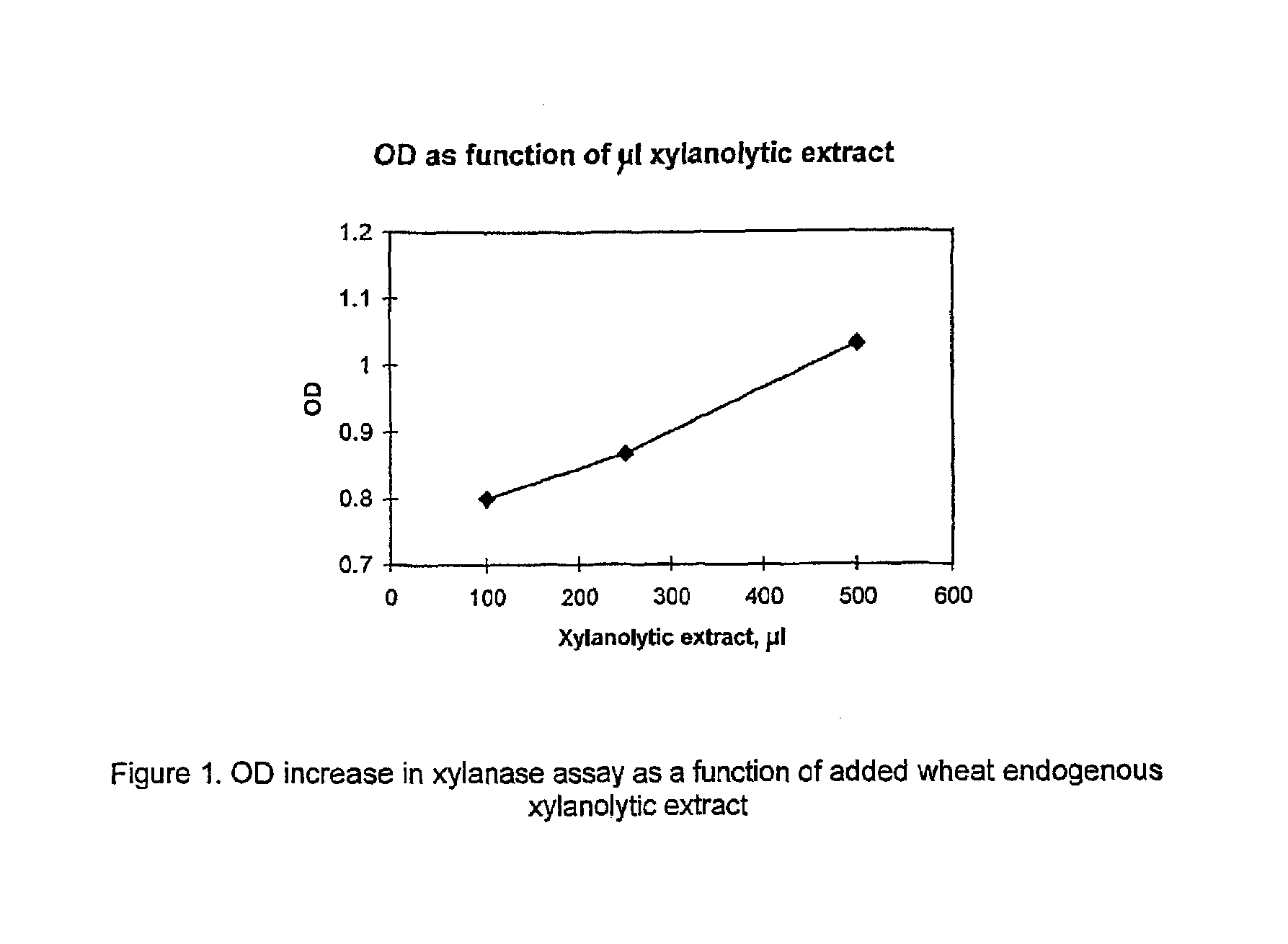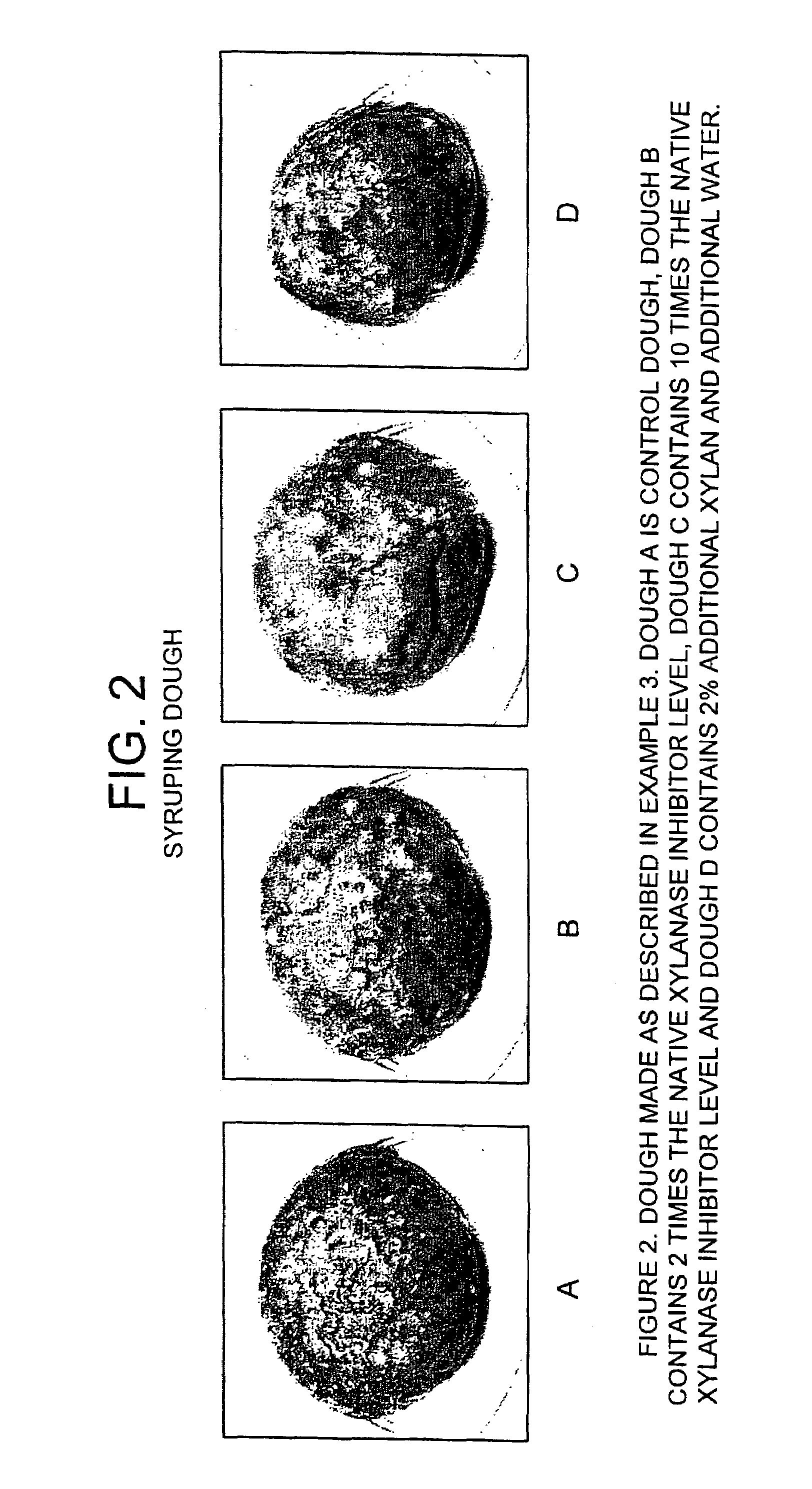Process of forming a refrigerated dough
a refrigerated dough and process technology, applied in the field of refrigerated dough preparation and process, can solve the problems of reducing the water holding capacity of the dough, adding hydrocolloids to the dough, and reducing the sugar level of the dough, so as to reduce the level of syruping, or even no level, the effect of easy preparation
- Summary
- Abstract
- Description
- Claims
- Application Information
AI Technical Summary
Benefits of technology
Problems solved by technology
Method used
Image
Examples
example 1
Purification of Wheat Endogenous Xylanase Inhibitor
[0079]2 kg wheat flour (Danish reform, batch 99056) was extracted with water, using a flour:water ratio of 1:2, during 10 minutes of stirring. The soluble endogenous xylanase inhibitor was separated from the flour-water slurry by centrifugation. The extraction and centrifugation was performed at 4° C. The inhibitor was purified from the water extract by the following chromatographic techniques and up-concentration techniques: HPLC-SEC, HPLC-CIEC, rotary evaporation, HPLC-HlC, HPLC-SEC and rotary evaporation. The xylanase inhibitor could be monitored during purification, using the xylanase inhibitor assay described in the above. To determine the amount of inhibitor obtained, the following Inhibitor quantification method was used.
Inhibitor Quantification Method
[0080]1 XIU (Xylanase Inhibitor Unit) is defined as the amount of inhibitor that decreases 1 TXU to 0.5 TXU under the conditions described below.
[0081]250 μl xylanase solution c...
example 2
Inhibition of Wheat Endogenous Xylanolytic Activities, using Purified Wheat Endogenous Xylanase Inhibitor
[0084]5 gram flour (batch 99056, containing 590 XIU / g) was extracted with 15 ml cold water for 10 minutes, by stirring. The soluble xylanolytic enzymes were separated from the flour-water slurry by centrifugation (10 minutes, 4° C., 10000 g). The supernatant contained the extractable xylanolytic enzymes. 12 ml xylanolytic extract was obtained.
[0085]Different amount of the xylanolytic extract was incubated with Xylazyme substrate (Megazyme, Ireland) with—and without additional purified wheat endogenous xylanase inhibitor. See detailed experimental set-up below (Table 2). The purified inhibitor contained 1200 XIU / ml. In all trials, the reaction volume of 1000 μl was reached by adding citric acid (0.1M)—di-sodium-hydrogen phosphate (0.2M) buffer, pH 5.0. Incubations was terminated by addition of 5 ml 2% TRIS / NaOH, pH 12 after 6 hours and 30 minutes.
[0086]
TABLE 2Experimental set-up f...
example 3
Dough Preparation and Evaluation Using Endogenous Xylanase Inhibitor
[0088]Doughs are prepared using the following recipe (Table 3) and flour 2000063.
[0089]
TABLE 3Recipe for making dough. Water was added to obtain 500Brabender Units (BU). Xylan is Birch wood xylan (Sigma).Flour,NaCl,Xylan,Water,XIUXIUDoughggggaddedtotalA501028030000B5010283000060000C501028270000300000D501130030000
[0090]Mixing of the above dough gave the following mixing data.
[0091]
TABLE 4Farinograph data obtained when mixing doughs described inTable 3.Water absorption,Development time,Dough% at 500 BUminStability, minA56.11.49.4B56.01.59.6C56.11.59.3D60.29.217.5
[0092]The above doughs (Table 3) were made by mixing for 5 minutes in a Farinograph mixer.
[0093]Doughs were kept in a sealed container (CO2 atmosphere was applied) for 10 days at 10° C. Doughs were evaluated visually at day 0 and day 10. In Table 5, the results are indicated. Furthermore, results are also visualised in FIG. 2. FIG. 2 clearly shows that the bro...
PUM
| Property | Measurement | Unit |
|---|---|---|
| pH | aaaaa | aaaaa |
| volume | aaaaa | aaaaa |
| volume | aaaaa | aaaaa |
Abstract
Description
Claims
Application Information
 Login to View More
Login to View More - R&D
- Intellectual Property
- Life Sciences
- Materials
- Tech Scout
- Unparalleled Data Quality
- Higher Quality Content
- 60% Fewer Hallucinations
Browse by: Latest US Patents, China's latest patents, Technical Efficacy Thesaurus, Application Domain, Technology Topic, Popular Technical Reports.
© 2025 PatSnap. All rights reserved.Legal|Privacy policy|Modern Slavery Act Transparency Statement|Sitemap|About US| Contact US: help@patsnap.com


